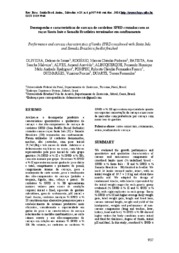Desempenho e características de carcaça de cordeiros SPRD cruzados com as raças Santa Inês e Somalis Brasileira terminados em confinamento.
Desempenho e características de carcaça de cordeiros SPRD cruzados com as raças Santa Inês e Somalis Brasileira terminados em confinamento.
Author(s): OLIVEIRA, D. de S.; ROGERIO, M. C. P.; BATISTA, A. S. M.; ALVES, A. A.; ALBUQUERQUE, F. H. M. A. R. de; POMPEU, R. C. F. F.; GUIMARAES, V. P.; DUARTE, T. F.
Summary: Resumo: Avaliou-se o desempenho produtivo e características quantitativas e qualitativas de carcaça e dos não-componentes de carcaça de cordeiros SPRD (Sem Padrão Racial Definido) cruzados com as raças Santa Inês (SI) e Somalis Brasileira (SB) terminados em confinamento. Foram utilizados 16 cordeiros desmamados, machos, não castrados, com peso inicial 19,7±2,0kg e três meses de idade. Adotou-se o delineamento em blocos ao acaso, com blocos representados pelo peso inicial de cada grupo genético (½ SPRD x ½ SI e ½ SPRD x ½ SB), com oito animais por grupo. Os ovinos ½ SPRD x ½ SI apresentaram maior ganho de peso diário e total, comprimento e perímetro de pernil, comprimento interno da carcaça, peso e rendimento do corte serrote, peso e rendimento dos não-componentes da carcaça (pulmão e traqueia, fígado, rins, cabeça e patas). Os cordeiros ½ SPRD x ½ SB apresentaram maiores valores para escore de condição corporal inicial e final, espessura de gordura subcutânea, grau de acabamento, pH inicial e final. Assim, cordeiros mestiços ½ SPRD x ½ SI constituem uma alternativa promissora para o estabelecimento de sistemas produtivos mais eficientes, considerando a superioridade em ganho de peso e as características da carcaça relacionadas às medidas morfométricas, ao corte cárneo serrote e aos não-componentes da carcaça em relação aos animais ½ SPRD x ½ SB. No entanto, os cordeiros os cordeiros ½ SPRD x ½ SB apresentam superioridade quanto aos aspectos conservação da carcaça e nos casos de mercados com preferência por carcaça com maior teor de gordura. [Performance and carcass characteristics of lambs SPRD crossbreed with Santa Inês and Somalis Brasileira feedlot finished]. Abstract: We evaluated the growth performance and quantitative and qualitative characteristics of carcass and non-carcass components of crossbred lambs meat (½ undefined breed - SPRD x ½ Santa Inês - SI and ½ SPRD x ½ Somalis Brasileira - SB) finished in feedlot. We used 16 lambs weaned males, intact, with an initial weight of 19.7 ± 2.0 kg and about three months old. We adopted the design of randomized blocks, with blocks represented by the initial weight ranges for each genetic group evaluated (½ SPRD x ½ SI and ½ SPRD x ½ SB), with eight replicates in each group. Sheep ½ SPRD x ½ SI had higher average daily weight gain, total weight gain, length and head ham, carcass internal length, weight and yield of the hindquarter, weights and performance of noncarcass components (lung and trachea, liver, kidney, head and feet). ½ SPRD x ½ SB showed higher values for body condition scores initial and final fat thickness, degree of finish, initial pH and final. In this study, crossbred ½ SPRD x ½ SI lambs is a promising alternative to obtaining of production systems more efficient considering the superiority of weight gain and carcass characteristics related to morphometric measurements, cut meat diet hacksaw and noncarcass components in the ½ SPRD x ½ SB animals. However, SPRD ½ x ½ SB lambs feature superiority as the conservation aspects of carcass and in the case of markets with preference for carcass with higher fat content.
Publication year: 2014
Types of publication: Journal article
Unit: Embrapa Goats & Sheep
Observation
Some of Embrapa's publications are published as ePub files. To read them, use or download one of the following free software options to your computer or mobile device. Android: Google Play Books; IOS: iBooks; Windows and Linux: Calibre.
Access other publications
Access the Agricultural Research Database (BDPA) to consult Embrapa's full library collection and records.
Visit Embrapa Bookstore to purchase books and other publications sold by Embrapa.

